Reflective Critique: Medication Errors in Mental Health Nursing
VerifiedAdded on 2023/01/16
|11
|3260
|65
AI Summary
This report discusses a medication error incident in mental health nursing, including the contributing factors and strategies for prevention. It highlights the importance of effective communication and the need for open disclosure in healthcare organizations.
Contribute Materials
Your contribution can guide someone’s learning journey. Share your
documents today.
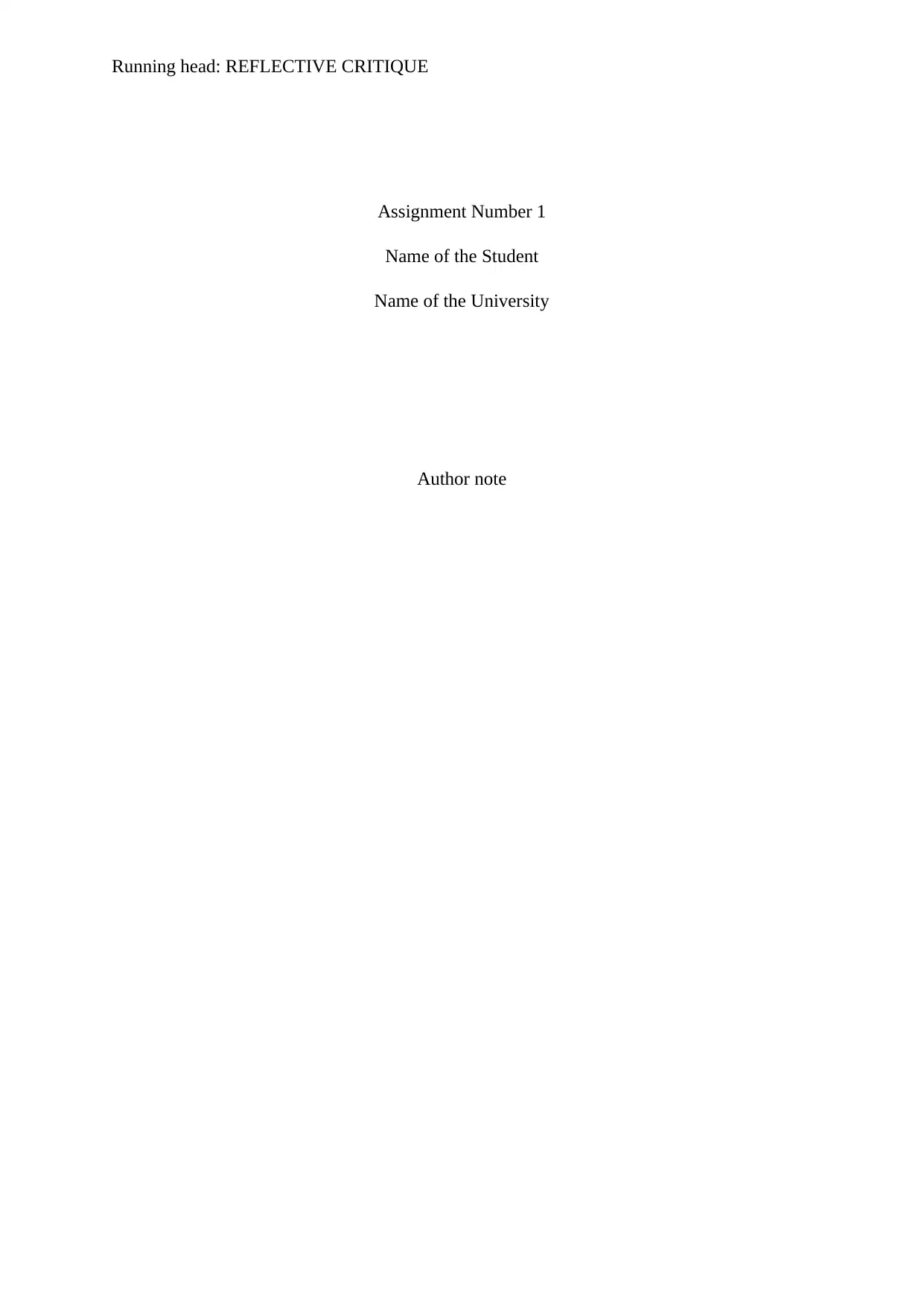
Running head: REFLECTIVE CRITIQUE
Assignment Number 1
Name of the Student
Name of the University
Author note
Assignment Number 1
Name of the Student
Name of the University
Author note
Secure Best Marks with AI Grader
Need help grading? Try our AI Grader for instant feedback on your assignments.
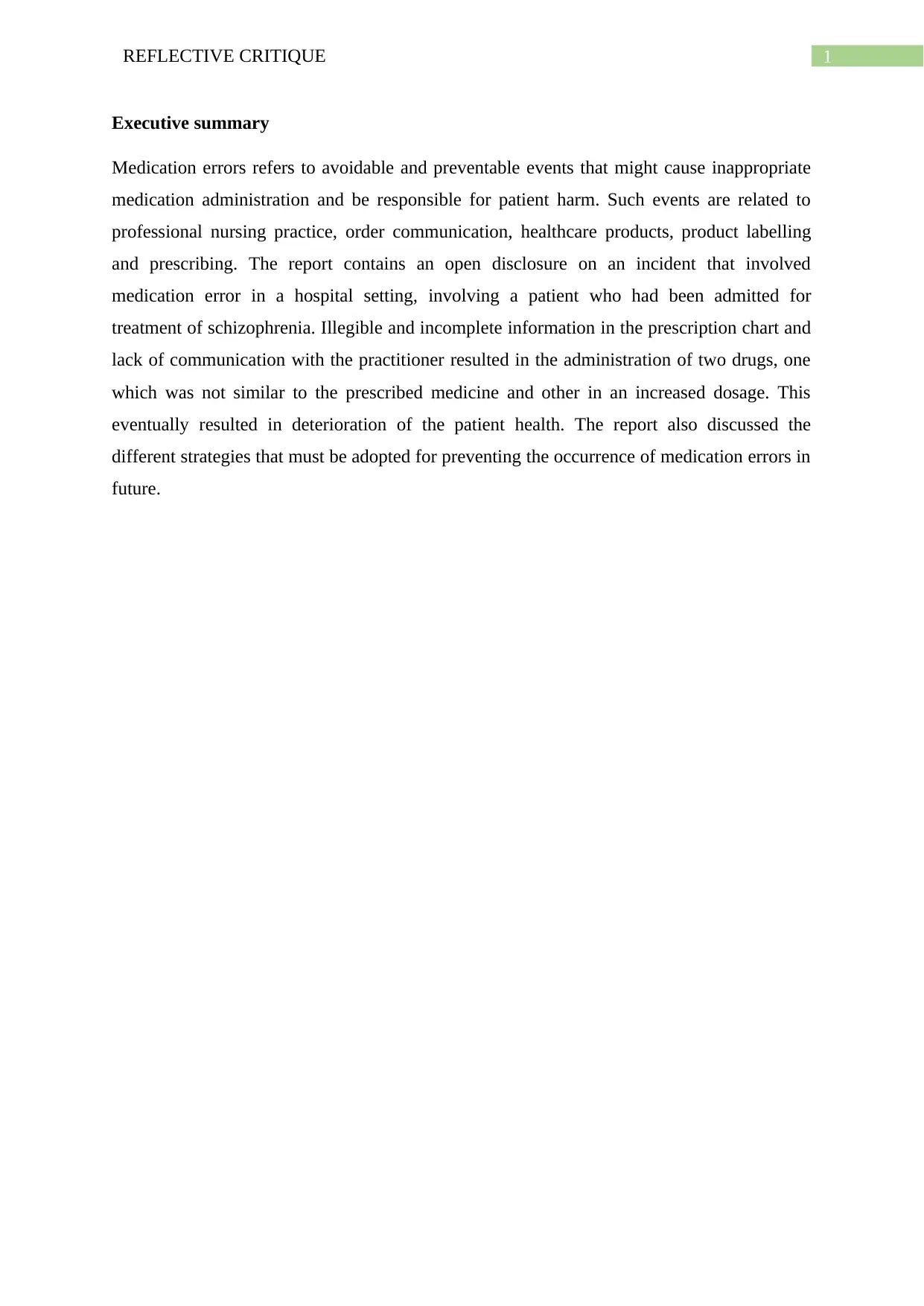
1REFLECTIVE CRITIQUE
Executive summary
Medication errors refers to avoidable and preventable events that might cause inappropriate
medication administration and be responsible for patient harm. Such events are related to
professional nursing practice, order communication, healthcare products, product labelling
and prescribing. The report contains an open disclosure on an incident that involved
medication error in a hospital setting, involving a patient who had been admitted for
treatment of schizophrenia. Illegible and incomplete information in the prescription chart and
lack of communication with the practitioner resulted in the administration of two drugs, one
which was not similar to the prescribed medicine and other in an increased dosage. This
eventually resulted in deterioration of the patient health. The report also discussed the
different strategies that must be adopted for preventing the occurrence of medication errors in
future.
Executive summary
Medication errors refers to avoidable and preventable events that might cause inappropriate
medication administration and be responsible for patient harm. Such events are related to
professional nursing practice, order communication, healthcare products, product labelling
and prescribing. The report contains an open disclosure on an incident that involved
medication error in a hospital setting, involving a patient who had been admitted for
treatment of schizophrenia. Illegible and incomplete information in the prescription chart and
lack of communication with the practitioner resulted in the administration of two drugs, one
which was not similar to the prescribed medicine and other in an increased dosage. This
eventually resulted in deterioration of the patient health. The report also discussed the
different strategies that must be adopted for preventing the occurrence of medication errors in
future.
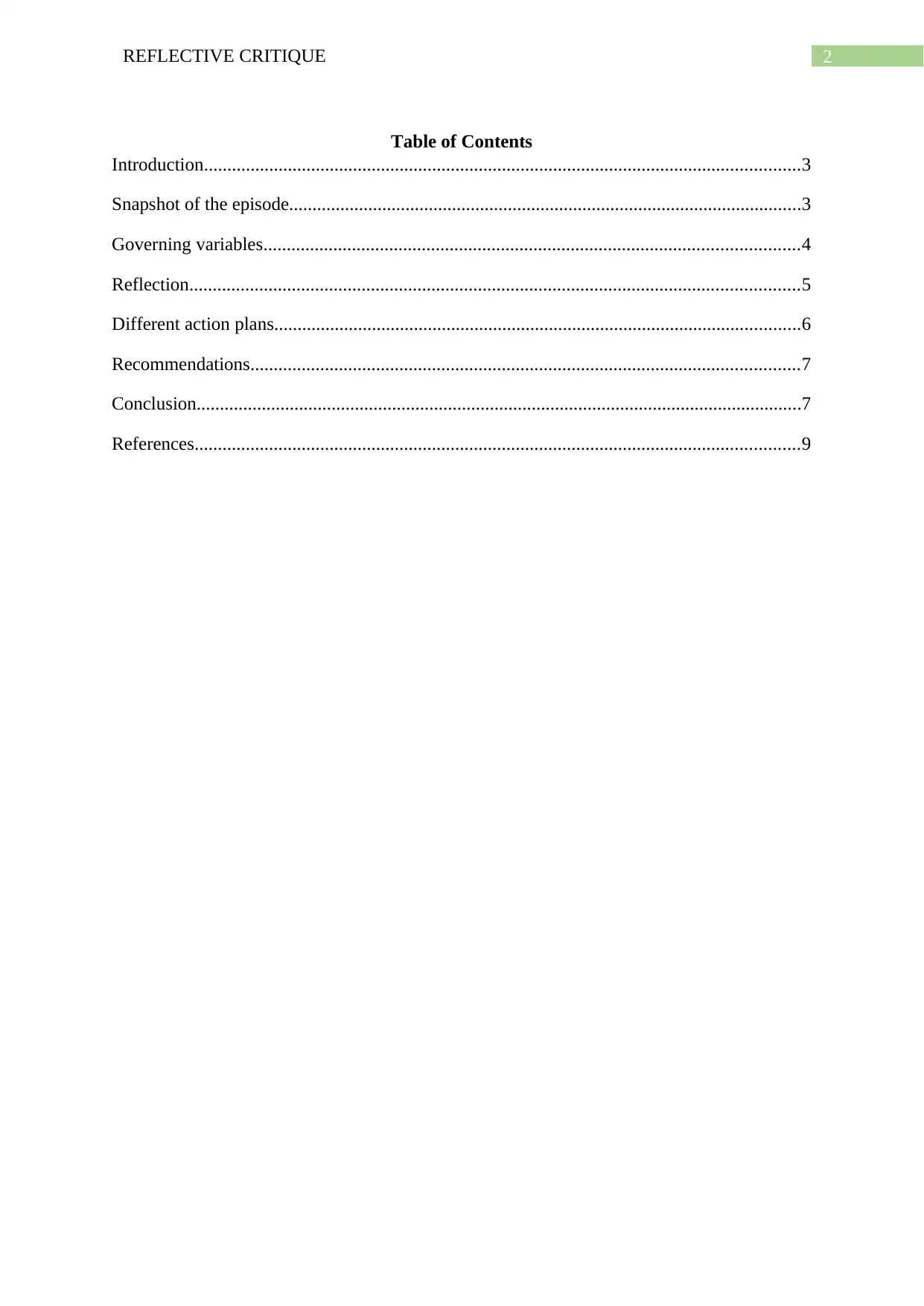
2REFLECTIVE CRITIQUE
Table of Contents
Introduction................................................................................................................................3
Snapshot of the episode..............................................................................................................3
Governing variables...................................................................................................................4
Reflection...................................................................................................................................5
Different action plans.................................................................................................................6
Recommendations......................................................................................................................7
Conclusion..................................................................................................................................7
References..................................................................................................................................9
Table of Contents
Introduction................................................................................................................................3
Snapshot of the episode..............................................................................................................3
Governing variables...................................................................................................................4
Reflection...................................................................................................................................5
Different action plans.................................................................................................................6
Recommendations......................................................................................................................7
Conclusion..................................................................................................................................7
References..................................................................................................................................9
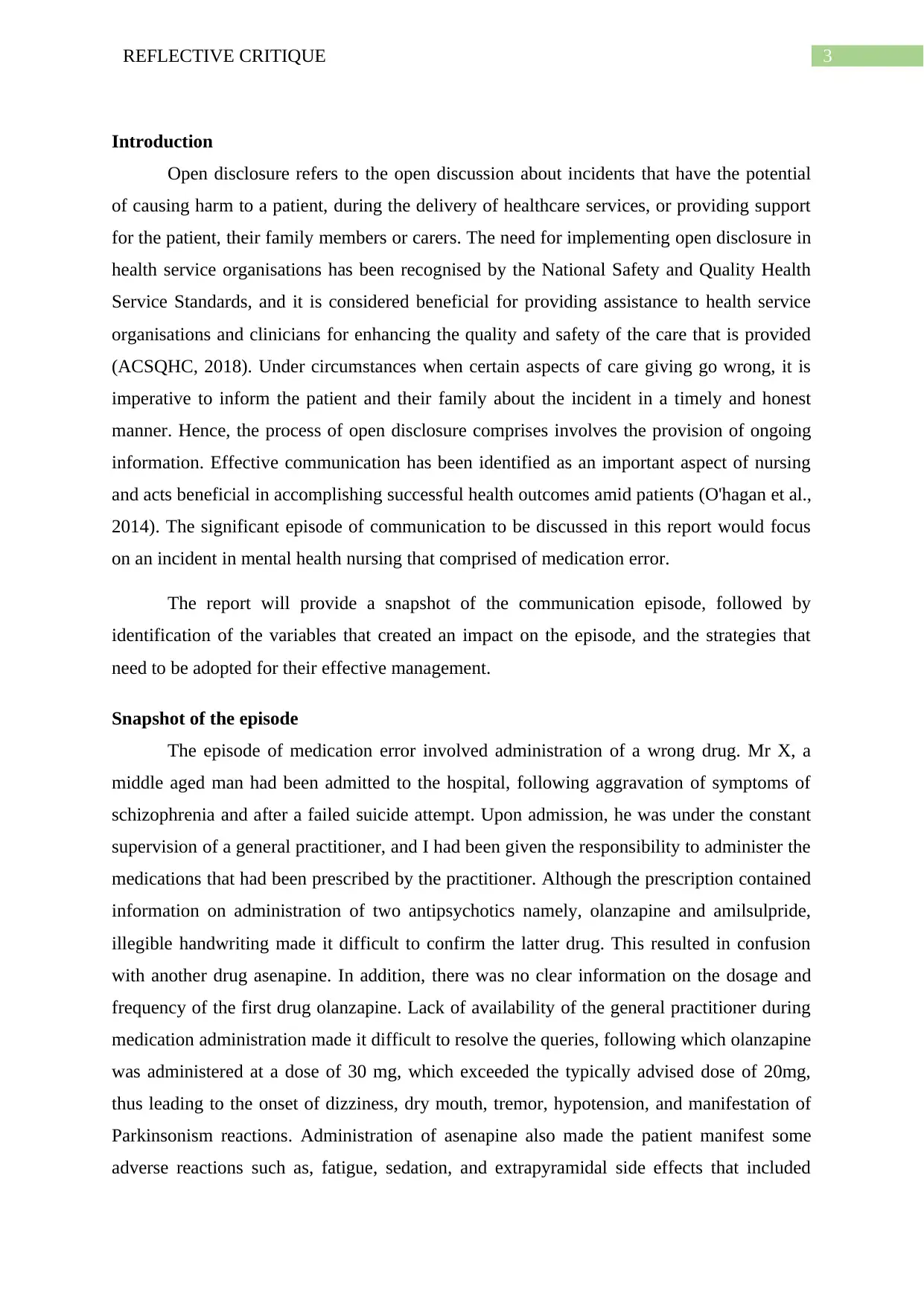
3REFLECTIVE CRITIQUE
Introduction
Open disclosure refers to the open discussion about incidents that have the potential
of causing harm to a patient, during the delivery of healthcare services, or providing support
for the patient, their family members or carers. The need for implementing open disclosure in
health service organisations has been recognised by the National Safety and Quality Health
Service Standards, and it is considered beneficial for providing assistance to health service
organisations and clinicians for enhancing the quality and safety of the care that is provided
(ACSQHC, 2018). Under circumstances when certain aspects of care giving go wrong, it is
imperative to inform the patient and their family about the incident in a timely and honest
manner. Hence, the process of open disclosure comprises involves the provision of ongoing
information. Effective communication has been identified as an important aspect of nursing
and acts beneficial in accomplishing successful health outcomes amid patients (O'hagan et al.,
2014). The significant episode of communication to be discussed in this report would focus
on an incident in mental health nursing that comprised of medication error.
The report will provide a snapshot of the communication episode, followed by
identification of the variables that created an impact on the episode, and the strategies that
need to be adopted for their effective management.
Snapshot of the episode
The episode of medication error involved administration of a wrong drug. Mr X, a
middle aged man had been admitted to the hospital, following aggravation of symptoms of
schizophrenia and after a failed suicide attempt. Upon admission, he was under the constant
supervision of a general practitioner, and I had been given the responsibility to administer the
medications that had been prescribed by the practitioner. Although the prescription contained
information on administration of two antipsychotics namely, olanzapine and amilsulpride,
illegible handwriting made it difficult to confirm the latter drug. This resulted in confusion
with another drug asenapine. In addition, there was no clear information on the dosage and
frequency of the first drug olanzapine. Lack of availability of the general practitioner during
medication administration made it difficult to resolve the queries, following which olanzapine
was administered at a dose of 30 mg, which exceeded the typically advised dose of 20mg,
thus leading to the onset of dizziness, dry mouth, tremor, hypotension, and manifestation of
Parkinsonism reactions. Administration of asenapine also made the patient manifest some
adverse reactions such as, fatigue, sedation, and extrapyramidal side effects that included
Introduction
Open disclosure refers to the open discussion about incidents that have the potential
of causing harm to a patient, during the delivery of healthcare services, or providing support
for the patient, their family members or carers. The need for implementing open disclosure in
health service organisations has been recognised by the National Safety and Quality Health
Service Standards, and it is considered beneficial for providing assistance to health service
organisations and clinicians for enhancing the quality and safety of the care that is provided
(ACSQHC, 2018). Under circumstances when certain aspects of care giving go wrong, it is
imperative to inform the patient and their family about the incident in a timely and honest
manner. Hence, the process of open disclosure comprises involves the provision of ongoing
information. Effective communication has been identified as an important aspect of nursing
and acts beneficial in accomplishing successful health outcomes amid patients (O'hagan et al.,
2014). The significant episode of communication to be discussed in this report would focus
on an incident in mental health nursing that comprised of medication error.
The report will provide a snapshot of the communication episode, followed by
identification of the variables that created an impact on the episode, and the strategies that
need to be adopted for their effective management.
Snapshot of the episode
The episode of medication error involved administration of a wrong drug. Mr X, a
middle aged man had been admitted to the hospital, following aggravation of symptoms of
schizophrenia and after a failed suicide attempt. Upon admission, he was under the constant
supervision of a general practitioner, and I had been given the responsibility to administer the
medications that had been prescribed by the practitioner. Although the prescription contained
information on administration of two antipsychotics namely, olanzapine and amilsulpride,
illegible handwriting made it difficult to confirm the latter drug. This resulted in confusion
with another drug asenapine. In addition, there was no clear information on the dosage and
frequency of the first drug olanzapine. Lack of availability of the general practitioner during
medication administration made it difficult to resolve the queries, following which olanzapine
was administered at a dose of 30 mg, which exceeded the typically advised dose of 20mg,
thus leading to the onset of dizziness, dry mouth, tremor, hypotension, and manifestation of
Parkinsonism reactions. Administration of asenapine also made the patient manifest some
adverse reactions such as, fatigue, sedation, and extrapyramidal side effects that included
Secure Best Marks with AI Grader
Need help grading? Try our AI Grader for instant feedback on your assignments.
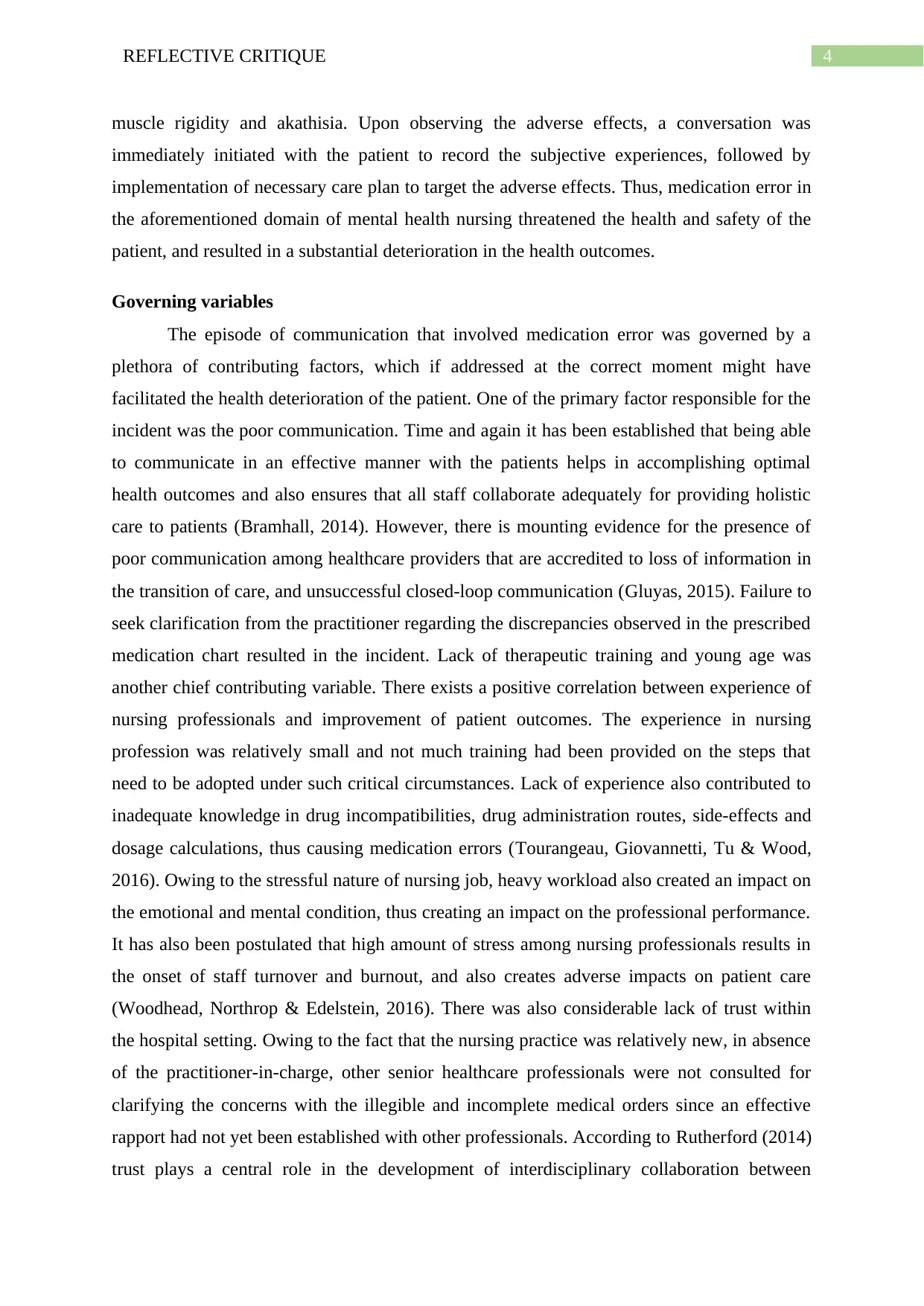
4REFLECTIVE CRITIQUE
muscle rigidity and akathisia. Upon observing the adverse effects, a conversation was
immediately initiated with the patient to record the subjective experiences, followed by
implementation of necessary care plan to target the adverse effects. Thus, medication error in
the aforementioned domain of mental health nursing threatened the health and safety of the
patient, and resulted in a substantial deterioration in the health outcomes.
Governing variables
The episode of communication that involved medication error was governed by a
plethora of contributing factors, which if addressed at the correct moment might have
facilitated the health deterioration of the patient. One of the primary factor responsible for the
incident was the poor communication. Time and again it has been established that being able
to communicate in an effective manner with the patients helps in accomplishing optimal
health outcomes and also ensures that all staff collaborate adequately for providing holistic
care to patients (Bramhall, 2014). However, there is mounting evidence for the presence of
poor communication among healthcare providers that are accredited to loss of information in
the transition of care, and unsuccessful closed-loop communication (Gluyas, 2015). Failure to
seek clarification from the practitioner regarding the discrepancies observed in the prescribed
medication chart resulted in the incident. Lack of therapeutic training and young age was
another chief contributing variable. There exists a positive correlation between experience of
nursing professionals and improvement of patient outcomes. The experience in nursing
profession was relatively small and not much training had been provided on the steps that
need to be adopted under such critical circumstances. Lack of experience also contributed to
inadequate knowledge in drug incompatibilities, drug administration routes, side-effects and
dosage calculations, thus causing medication errors (Tourangeau, Giovannetti, Tu & Wood,
2016). Owing to the stressful nature of nursing job, heavy workload also created an impact on
the emotional and mental condition, thus creating an impact on the professional performance.
It has also been postulated that high amount of stress among nursing professionals results in
the onset of staff turnover and burnout, and also creates adverse impacts on patient care
(Woodhead, Northrop & Edelstein, 2016). There was also considerable lack of trust within
the hospital setting. Owing to the fact that the nursing practice was relatively new, in absence
of the practitioner-in-charge, other senior healthcare professionals were not consulted for
clarifying the concerns with the illegible and incomplete medical orders since an effective
rapport had not yet been established with other professionals. According to Rutherford (2014)
trust plays a central role in the development of interdisciplinary collaboration between
muscle rigidity and akathisia. Upon observing the adverse effects, a conversation was
immediately initiated with the patient to record the subjective experiences, followed by
implementation of necessary care plan to target the adverse effects. Thus, medication error in
the aforementioned domain of mental health nursing threatened the health and safety of the
patient, and resulted in a substantial deterioration in the health outcomes.
Governing variables
The episode of communication that involved medication error was governed by a
plethora of contributing factors, which if addressed at the correct moment might have
facilitated the health deterioration of the patient. One of the primary factor responsible for the
incident was the poor communication. Time and again it has been established that being able
to communicate in an effective manner with the patients helps in accomplishing optimal
health outcomes and also ensures that all staff collaborate adequately for providing holistic
care to patients (Bramhall, 2014). However, there is mounting evidence for the presence of
poor communication among healthcare providers that are accredited to loss of information in
the transition of care, and unsuccessful closed-loop communication (Gluyas, 2015). Failure to
seek clarification from the practitioner regarding the discrepancies observed in the prescribed
medication chart resulted in the incident. Lack of therapeutic training and young age was
another chief contributing variable. There exists a positive correlation between experience of
nursing professionals and improvement of patient outcomes. The experience in nursing
profession was relatively small and not much training had been provided on the steps that
need to be adopted under such critical circumstances. Lack of experience also contributed to
inadequate knowledge in drug incompatibilities, drug administration routes, side-effects and
dosage calculations, thus causing medication errors (Tourangeau, Giovannetti, Tu & Wood,
2016). Owing to the stressful nature of nursing job, heavy workload also created an impact on
the emotional and mental condition, thus creating an impact on the professional performance.
It has also been postulated that high amount of stress among nursing professionals results in
the onset of staff turnover and burnout, and also creates adverse impacts on patient care
(Woodhead, Northrop & Edelstein, 2016). There was also considerable lack of trust within
the hospital setting. Owing to the fact that the nursing practice was relatively new, in absence
of the practitioner-in-charge, other senior healthcare professionals were not consulted for
clarifying the concerns with the illegible and incomplete medical orders since an effective
rapport had not yet been established with other professionals. According to Rutherford (2014)
trust plays a central role in the development of interdisciplinary collaboration between
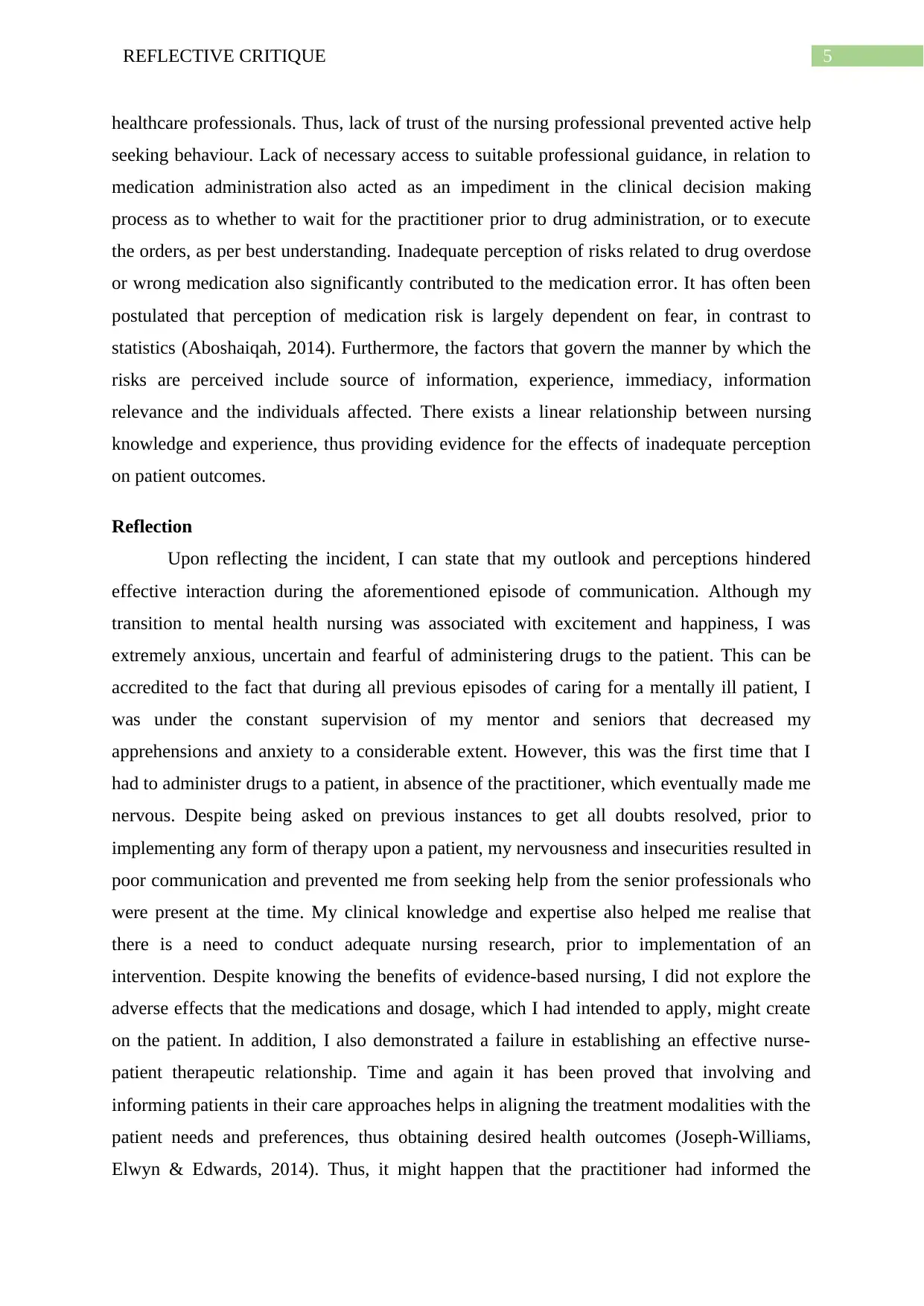
5REFLECTIVE CRITIQUE
healthcare professionals. Thus, lack of trust of the nursing professional prevented active help
seeking behaviour. Lack of necessary access to suitable professional guidance, in relation to
medication administration also acted as an impediment in the clinical decision making
process as to whether to wait for the practitioner prior to drug administration, or to execute
the orders, as per best understanding. Inadequate perception of risks related to drug overdose
or wrong medication also significantly contributed to the medication error. It has often been
postulated that perception of medication risk is largely dependent on fear, in contrast to
statistics (Aboshaiqah, 2014). Furthermore, the factors that govern the manner by which the
risks are perceived include source of information, experience, immediacy, information
relevance and the individuals affected. There exists a linear relationship between nursing
knowledge and experience, thus providing evidence for the effects of inadequate perception
on patient outcomes.
Reflection
Upon reflecting the incident, I can state that my outlook and perceptions hindered
effective interaction during the aforementioned episode of communication. Although my
transition to mental health nursing was associated with excitement and happiness, I was
extremely anxious, uncertain and fearful of administering drugs to the patient. This can be
accredited to the fact that during all previous episodes of caring for a mentally ill patient, I
was under the constant supervision of my mentor and seniors that decreased my
apprehensions and anxiety to a considerable extent. However, this was the first time that I
had to administer drugs to a patient, in absence of the practitioner, which eventually made me
nervous. Despite being asked on previous instances to get all doubts resolved, prior to
implementing any form of therapy upon a patient, my nervousness and insecurities resulted in
poor communication and prevented me from seeking help from the senior professionals who
were present at the time. My clinical knowledge and expertise also helped me realise that
there is a need to conduct adequate nursing research, prior to implementation of an
intervention. Despite knowing the benefits of evidence-based nursing, I did not explore the
adverse effects that the medications and dosage, which I had intended to apply, might create
on the patient. In addition, I also demonstrated a failure in establishing an effective nurse-
patient therapeutic relationship. Time and again it has been proved that involving and
informing patients in their care approaches helps in aligning the treatment modalities with the
patient needs and preferences, thus obtaining desired health outcomes (Joseph-Williams,
Elwyn & Edwards, 2014). Thus, it might happen that the practitioner had informed the
healthcare professionals. Thus, lack of trust of the nursing professional prevented active help
seeking behaviour. Lack of necessary access to suitable professional guidance, in relation to
medication administration also acted as an impediment in the clinical decision making
process as to whether to wait for the practitioner prior to drug administration, or to execute
the orders, as per best understanding. Inadequate perception of risks related to drug overdose
or wrong medication also significantly contributed to the medication error. It has often been
postulated that perception of medication risk is largely dependent on fear, in contrast to
statistics (Aboshaiqah, 2014). Furthermore, the factors that govern the manner by which the
risks are perceived include source of information, experience, immediacy, information
relevance and the individuals affected. There exists a linear relationship between nursing
knowledge and experience, thus providing evidence for the effects of inadequate perception
on patient outcomes.
Reflection
Upon reflecting the incident, I can state that my outlook and perceptions hindered
effective interaction during the aforementioned episode of communication. Although my
transition to mental health nursing was associated with excitement and happiness, I was
extremely anxious, uncertain and fearful of administering drugs to the patient. This can be
accredited to the fact that during all previous episodes of caring for a mentally ill patient, I
was under the constant supervision of my mentor and seniors that decreased my
apprehensions and anxiety to a considerable extent. However, this was the first time that I
had to administer drugs to a patient, in absence of the practitioner, which eventually made me
nervous. Despite being asked on previous instances to get all doubts resolved, prior to
implementing any form of therapy upon a patient, my nervousness and insecurities resulted in
poor communication and prevented me from seeking help from the senior professionals who
were present at the time. My clinical knowledge and expertise also helped me realise that
there is a need to conduct adequate nursing research, prior to implementation of an
intervention. Despite knowing the benefits of evidence-based nursing, I did not explore the
adverse effects that the medications and dosage, which I had intended to apply, might create
on the patient. In addition, I also demonstrated a failure in establishing an effective nurse-
patient therapeutic relationship. Time and again it has been proved that involving and
informing patients in their care approaches helps in aligning the treatment modalities with the
patient needs and preferences, thus obtaining desired health outcomes (Joseph-Williams,
Elwyn & Edwards, 2014). Thus, it might happen that the practitioner had informed the
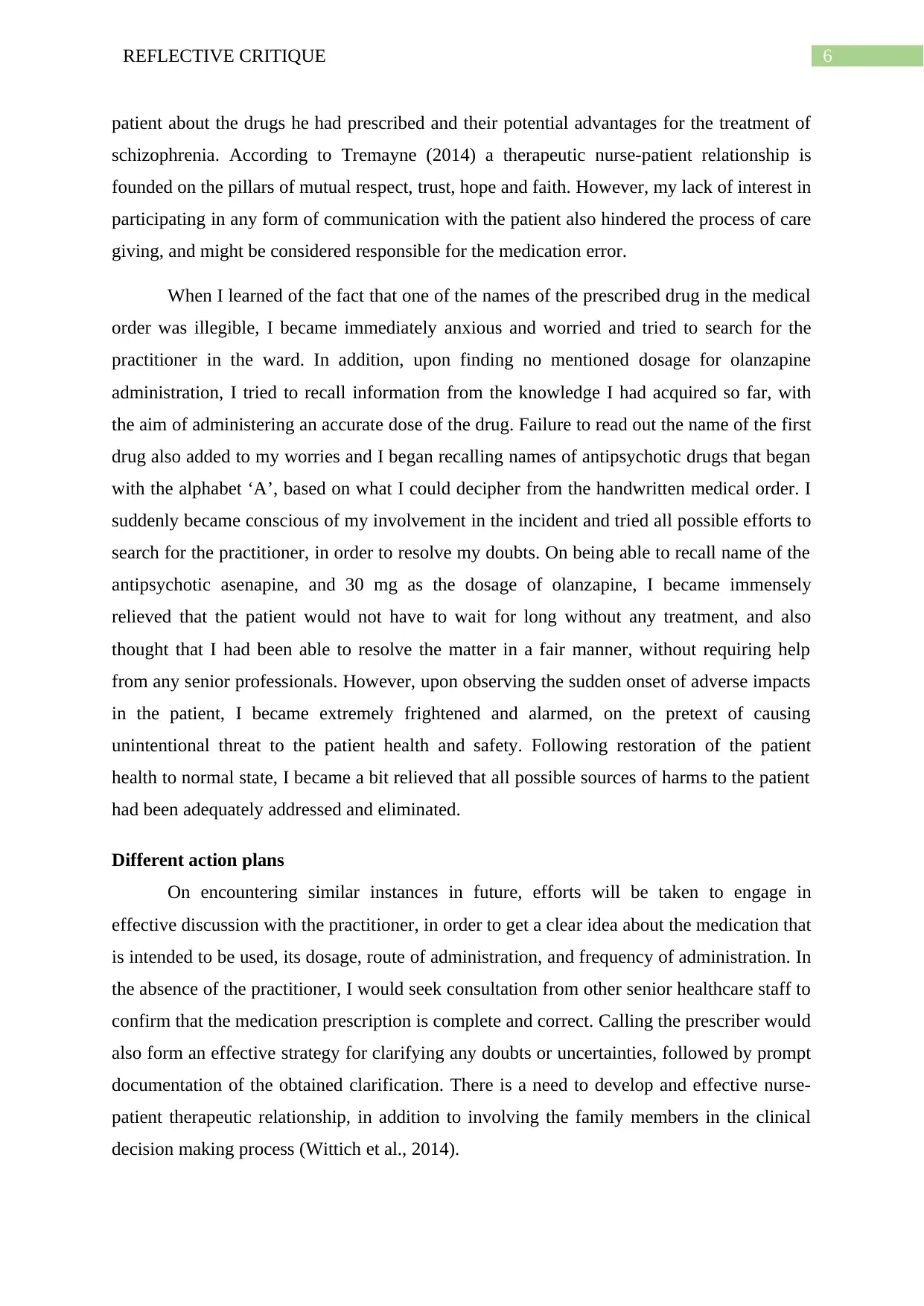
6REFLECTIVE CRITIQUE
patient about the drugs he had prescribed and their potential advantages for the treatment of
schizophrenia. According to Tremayne (2014) a therapeutic nurse-patient relationship is
founded on the pillars of mutual respect, trust, hope and faith. However, my lack of interest in
participating in any form of communication with the patient also hindered the process of care
giving, and might be considered responsible for the medication error.
When I learned of the fact that one of the names of the prescribed drug in the medical
order was illegible, I became immediately anxious and worried and tried to search for the
practitioner in the ward. In addition, upon finding no mentioned dosage for olanzapine
administration, I tried to recall information from the knowledge I had acquired so far, with
the aim of administering an accurate dose of the drug. Failure to read out the name of the first
drug also added to my worries and I began recalling names of antipsychotic drugs that began
with the alphabet ‘A’, based on what I could decipher from the handwritten medical order. I
suddenly became conscious of my involvement in the incident and tried all possible efforts to
search for the practitioner, in order to resolve my doubts. On being able to recall name of the
antipsychotic asenapine, and 30 mg as the dosage of olanzapine, I became immensely
relieved that the patient would not have to wait for long without any treatment, and also
thought that I had been able to resolve the matter in a fair manner, without requiring help
from any senior professionals. However, upon observing the sudden onset of adverse impacts
in the patient, I became extremely frightened and alarmed, on the pretext of causing
unintentional threat to the patient health and safety. Following restoration of the patient
health to normal state, I became a bit relieved that all possible sources of harms to the patient
had been adequately addressed and eliminated.
Different action plans
On encountering similar instances in future, efforts will be taken to engage in
effective discussion with the practitioner, in order to get a clear idea about the medication that
is intended to be used, its dosage, route of administration, and frequency of administration. In
the absence of the practitioner, I would seek consultation from other senior healthcare staff to
confirm that the medication prescription is complete and correct. Calling the prescriber would
also form an effective strategy for clarifying any doubts or uncertainties, followed by prompt
documentation of the obtained clarification. There is a need to develop and effective nurse-
patient therapeutic relationship, in addition to involving the family members in the clinical
decision making process (Wittich et al., 2014).
patient about the drugs he had prescribed and their potential advantages for the treatment of
schizophrenia. According to Tremayne (2014) a therapeutic nurse-patient relationship is
founded on the pillars of mutual respect, trust, hope and faith. However, my lack of interest in
participating in any form of communication with the patient also hindered the process of care
giving, and might be considered responsible for the medication error.
When I learned of the fact that one of the names of the prescribed drug in the medical
order was illegible, I became immediately anxious and worried and tried to search for the
practitioner in the ward. In addition, upon finding no mentioned dosage for olanzapine
administration, I tried to recall information from the knowledge I had acquired so far, with
the aim of administering an accurate dose of the drug. Failure to read out the name of the first
drug also added to my worries and I began recalling names of antipsychotic drugs that began
with the alphabet ‘A’, based on what I could decipher from the handwritten medical order. I
suddenly became conscious of my involvement in the incident and tried all possible efforts to
search for the practitioner, in order to resolve my doubts. On being able to recall name of the
antipsychotic asenapine, and 30 mg as the dosage of olanzapine, I became immensely
relieved that the patient would not have to wait for long without any treatment, and also
thought that I had been able to resolve the matter in a fair manner, without requiring help
from any senior professionals. However, upon observing the sudden onset of adverse impacts
in the patient, I became extremely frightened and alarmed, on the pretext of causing
unintentional threat to the patient health and safety. Following restoration of the patient
health to normal state, I became a bit relieved that all possible sources of harms to the patient
had been adequately addressed and eliminated.
Different action plans
On encountering similar instances in future, efforts will be taken to engage in
effective discussion with the practitioner, in order to get a clear idea about the medication that
is intended to be used, its dosage, route of administration, and frequency of administration. In
the absence of the practitioner, I would seek consultation from other senior healthcare staff to
confirm that the medication prescription is complete and correct. Calling the prescriber would
also form an effective strategy for clarifying any doubts or uncertainties, followed by prompt
documentation of the obtained clarification. There is a need to develop and effective nurse-
patient therapeutic relationship, in addition to involving the family members in the clinical
decision making process (Wittich et al., 2014).
Paraphrase This Document
Need a fresh take? Get an instant paraphrase of this document with our AI Paraphraser
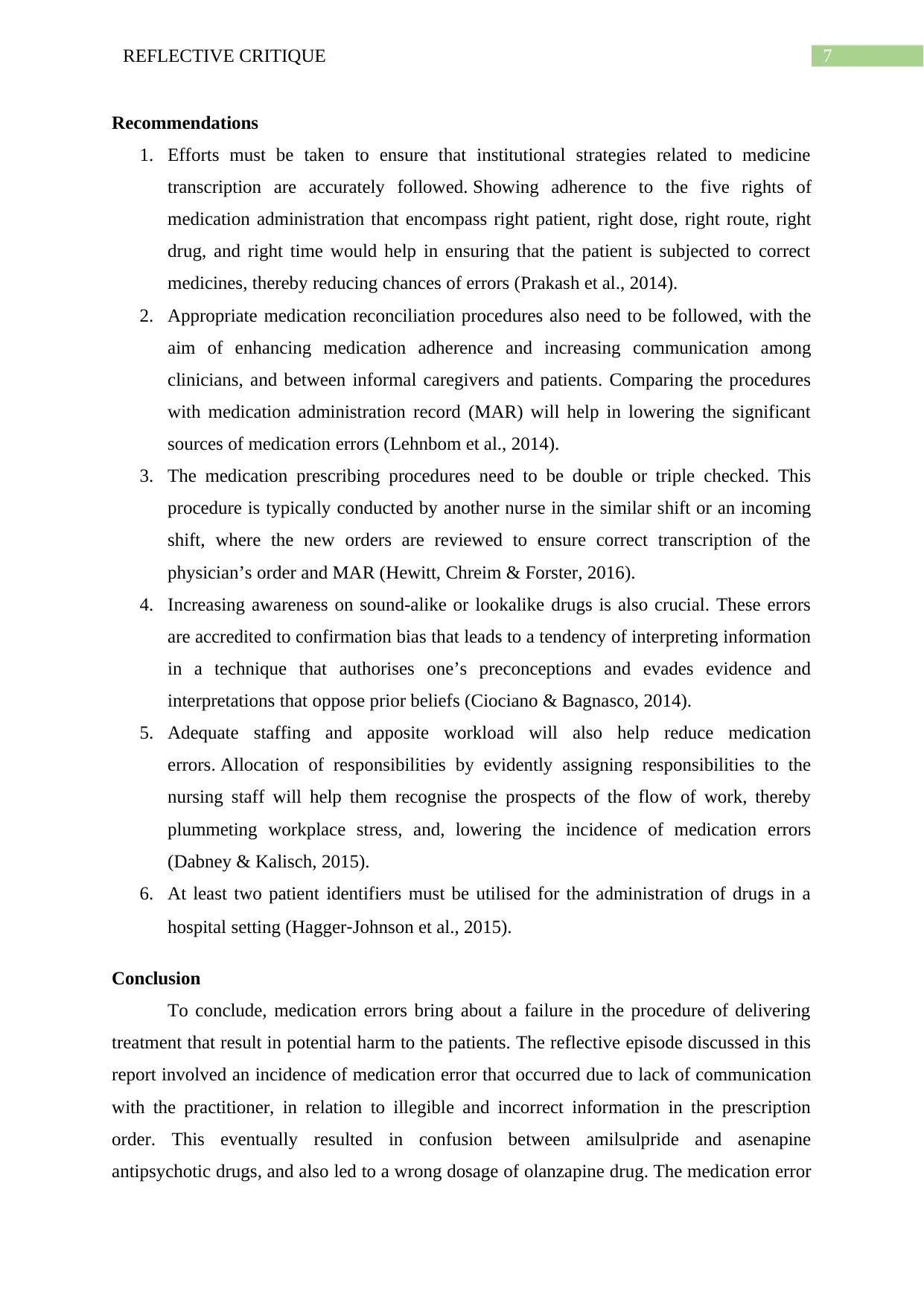
7REFLECTIVE CRITIQUE
Recommendations
1. Efforts must be taken to ensure that institutional strategies related to medicine
transcription are accurately followed. Showing adherence to the five rights of
medication administration that encompass right patient, right dose, right route, right
drug, and right time would help in ensuring that the patient is subjected to correct
medicines, thereby reducing chances of errors (Prakash et al., 2014).
2. Appropriate medication reconciliation procedures also need to be followed, with the
aim of enhancing medication adherence and increasing communication among
clinicians, and between informal caregivers and patients. Comparing the procedures
with medication administration record (MAR) will help in lowering the significant
sources of medication errors (Lehnbom et al., 2014).
3. The medication prescribing procedures need to be double or triple checked. This
procedure is typically conducted by another nurse in the similar shift or an incoming
shift, where the new orders are reviewed to ensure correct transcription of the
physician’s order and MAR (Hewitt, Chreim & Forster, 2016).
4. Increasing awareness on sound-alike or lookalike drugs is also crucial. These errors
are accredited to confirmation bias that leads to a tendency of interpreting information
in a technique that authorises one’s preconceptions and evades evidence and
interpretations that oppose prior beliefs (Ciociano & Bagnasco, 2014).
5. Adequate staffing and apposite workload will also help reduce medication
errors. Allocation of responsibilities by evidently assigning responsibilities to the
nursing staff will help them recognise the prospects of the flow of work, thereby
plummeting workplace stress, and, lowering the incidence of medication errors
(Dabney & Kalisch, 2015).
6. At least two patient identifiers must be utilised for the administration of drugs in a
hospital setting (Hagger‐Johnson et al., 2015).
Conclusion
To conclude, medication errors bring about a failure in the procedure of delivering
treatment that result in potential harm to the patients. The reflective episode discussed in this
report involved an incidence of medication error that occurred due to lack of communication
with the practitioner, in relation to illegible and incorrect information in the prescription
order. This eventually resulted in confusion between amilsulpride and asenapine
antipsychotic drugs, and also led to a wrong dosage of olanzapine drug. The medication error
Recommendations
1. Efforts must be taken to ensure that institutional strategies related to medicine
transcription are accurately followed. Showing adherence to the five rights of
medication administration that encompass right patient, right dose, right route, right
drug, and right time would help in ensuring that the patient is subjected to correct
medicines, thereby reducing chances of errors (Prakash et al., 2014).
2. Appropriate medication reconciliation procedures also need to be followed, with the
aim of enhancing medication adherence and increasing communication among
clinicians, and between informal caregivers and patients. Comparing the procedures
with medication administration record (MAR) will help in lowering the significant
sources of medication errors (Lehnbom et al., 2014).
3. The medication prescribing procedures need to be double or triple checked. This
procedure is typically conducted by another nurse in the similar shift or an incoming
shift, where the new orders are reviewed to ensure correct transcription of the
physician’s order and MAR (Hewitt, Chreim & Forster, 2016).
4. Increasing awareness on sound-alike or lookalike drugs is also crucial. These errors
are accredited to confirmation bias that leads to a tendency of interpreting information
in a technique that authorises one’s preconceptions and evades evidence and
interpretations that oppose prior beliefs (Ciociano & Bagnasco, 2014).
5. Adequate staffing and apposite workload will also help reduce medication
errors. Allocation of responsibilities by evidently assigning responsibilities to the
nursing staff will help them recognise the prospects of the flow of work, thereby
plummeting workplace stress, and, lowering the incidence of medication errors
(Dabney & Kalisch, 2015).
6. At least two patient identifiers must be utilised for the administration of drugs in a
hospital setting (Hagger‐Johnson et al., 2015).
Conclusion
To conclude, medication errors bring about a failure in the procedure of delivering
treatment that result in potential harm to the patients. The reflective episode discussed in this
report involved an incidence of medication error that occurred due to lack of communication
with the practitioner, in relation to illegible and incorrect information in the prescription
order. This eventually resulted in confusion between amilsulpride and asenapine
antipsychotic drugs, and also led to a wrong dosage of olanzapine drug. The medication error
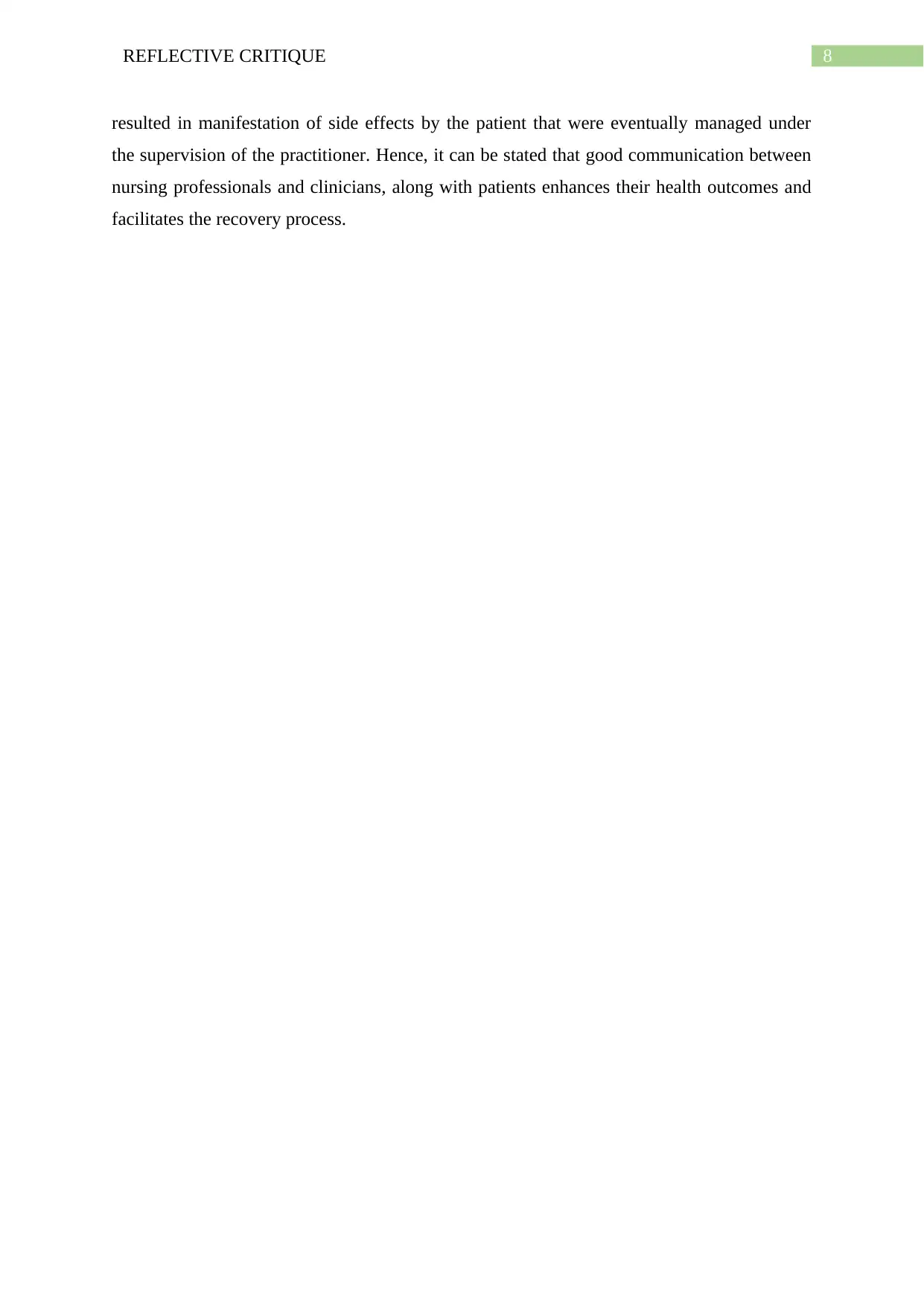
8REFLECTIVE CRITIQUE
resulted in manifestation of side effects by the patient that were eventually managed under
the supervision of the practitioner. Hence, it can be stated that good communication between
nursing professionals and clinicians, along with patients enhances their health outcomes and
facilitates the recovery process.
resulted in manifestation of side effects by the patient that were eventually managed under
the supervision of the practitioner. Hence, it can be stated that good communication between
nursing professionals and clinicians, along with patients enhances their health outcomes and
facilitates the recovery process.
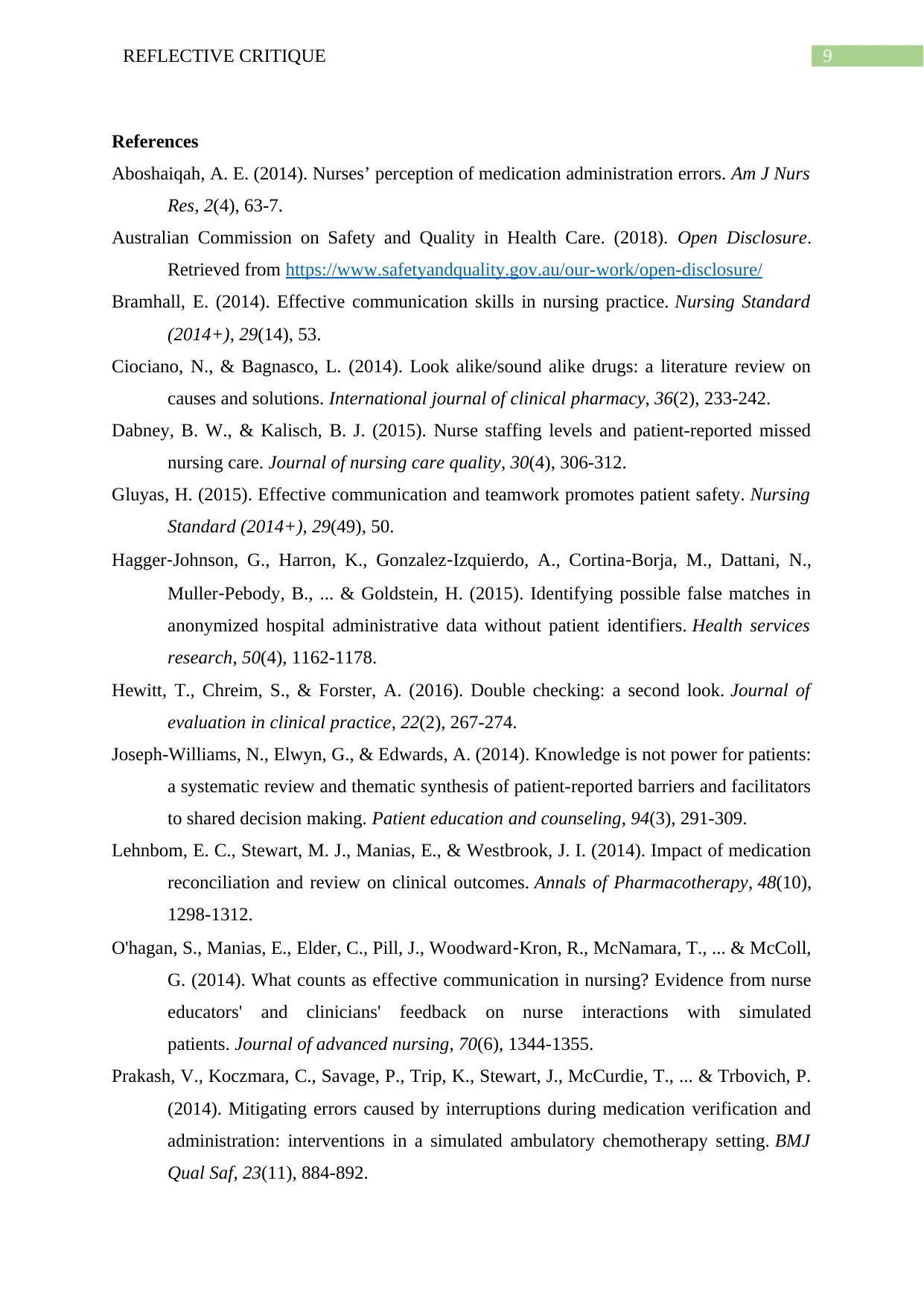
9REFLECTIVE CRITIQUE
References
Aboshaiqah, A. E. (2014). Nurses’ perception of medication administration errors. Am J Nurs
Res, 2(4), 63-7.
Australian Commission on Safety and Quality in Health Care. (2018). Open Disclosure.
Retrieved from https://www.safetyandquality.gov.au/our-work/open-disclosure/
Bramhall, E. (2014). Effective communication skills in nursing practice. Nursing Standard
(2014+), 29(14), 53.
Ciociano, N., & Bagnasco, L. (2014). Look alike/sound alike drugs: a literature review on
causes and solutions. International journal of clinical pharmacy, 36(2), 233-242.
Dabney, B. W., & Kalisch, B. J. (2015). Nurse staffing levels and patient-reported missed
nursing care. Journal of nursing care quality, 30(4), 306-312.
Gluyas, H. (2015). Effective communication and teamwork promotes patient safety. Nursing
Standard (2014+), 29(49), 50.
Hagger‐Johnson, G., Harron, K., Gonzalez‐Izquierdo, A., Cortina‐Borja, M., Dattani, N.,
Muller‐Pebody, B., ... & Goldstein, H. (2015). Identifying possible false matches in
anonymized hospital administrative data without patient identifiers. Health services
research, 50(4), 1162-1178.
Hewitt, T., Chreim, S., & Forster, A. (2016). Double checking: a second look. Journal of
evaluation in clinical practice, 22(2), 267-274.
Joseph-Williams, N., Elwyn, G., & Edwards, A. (2014). Knowledge is not power for patients:
a systematic review and thematic synthesis of patient-reported barriers and facilitators
to shared decision making. Patient education and counseling, 94(3), 291-309.
Lehnbom, E. C., Stewart, M. J., Manias, E., & Westbrook, J. I. (2014). Impact of medication
reconciliation and review on clinical outcomes. Annals of Pharmacotherapy, 48(10),
1298-1312.
O'hagan, S., Manias, E., Elder, C., Pill, J., Woodward‐Kron, R., McNamara, T., ... & McColl,
G. (2014). What counts as effective communication in nursing? Evidence from nurse
educators' and clinicians' feedback on nurse interactions with simulated
patients. Journal of advanced nursing, 70(6), 1344-1355.
Prakash, V., Koczmara, C., Savage, P., Trip, K., Stewart, J., McCurdie, T., ... & Trbovich, P.
(2014). Mitigating errors caused by interruptions during medication verification and
administration: interventions in a simulated ambulatory chemotherapy setting. BMJ
Qual Saf, 23(11), 884-892.
References
Aboshaiqah, A. E. (2014). Nurses’ perception of medication administration errors. Am J Nurs
Res, 2(4), 63-7.
Australian Commission on Safety and Quality in Health Care. (2018). Open Disclosure.
Retrieved from https://www.safetyandquality.gov.au/our-work/open-disclosure/
Bramhall, E. (2014). Effective communication skills in nursing practice. Nursing Standard
(2014+), 29(14), 53.
Ciociano, N., & Bagnasco, L. (2014). Look alike/sound alike drugs: a literature review on
causes and solutions. International journal of clinical pharmacy, 36(2), 233-242.
Dabney, B. W., & Kalisch, B. J. (2015). Nurse staffing levels and patient-reported missed
nursing care. Journal of nursing care quality, 30(4), 306-312.
Gluyas, H. (2015). Effective communication and teamwork promotes patient safety. Nursing
Standard (2014+), 29(49), 50.
Hagger‐Johnson, G., Harron, K., Gonzalez‐Izquierdo, A., Cortina‐Borja, M., Dattani, N.,
Muller‐Pebody, B., ... & Goldstein, H. (2015). Identifying possible false matches in
anonymized hospital administrative data without patient identifiers. Health services
research, 50(4), 1162-1178.
Hewitt, T., Chreim, S., & Forster, A. (2016). Double checking: a second look. Journal of
evaluation in clinical practice, 22(2), 267-274.
Joseph-Williams, N., Elwyn, G., & Edwards, A. (2014). Knowledge is not power for patients:
a systematic review and thematic synthesis of patient-reported barriers and facilitators
to shared decision making. Patient education and counseling, 94(3), 291-309.
Lehnbom, E. C., Stewart, M. J., Manias, E., & Westbrook, J. I. (2014). Impact of medication
reconciliation and review on clinical outcomes. Annals of Pharmacotherapy, 48(10),
1298-1312.
O'hagan, S., Manias, E., Elder, C., Pill, J., Woodward‐Kron, R., McNamara, T., ... & McColl,
G. (2014). What counts as effective communication in nursing? Evidence from nurse
educators' and clinicians' feedback on nurse interactions with simulated
patients. Journal of advanced nursing, 70(6), 1344-1355.
Prakash, V., Koczmara, C., Savage, P., Trip, K., Stewart, J., McCurdie, T., ... & Trbovich, P.
(2014). Mitigating errors caused by interruptions during medication verification and
administration: interventions in a simulated ambulatory chemotherapy setting. BMJ
Qual Saf, 23(11), 884-892.
Secure Best Marks with AI Grader
Need help grading? Try our AI Grader for instant feedback on your assignments.
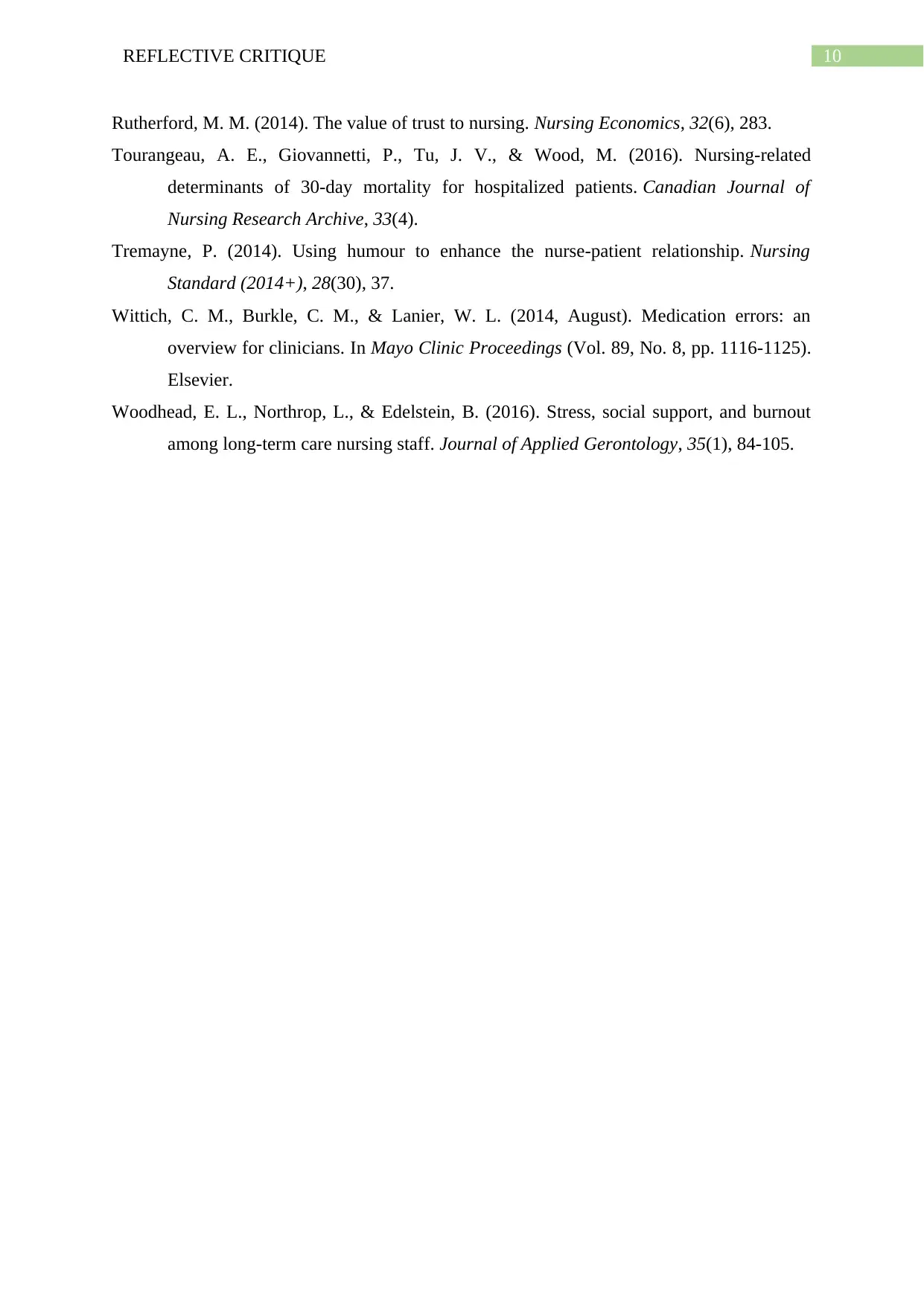
10REFLECTIVE CRITIQUE
Rutherford, M. M. (2014). The value of trust to nursing. Nursing Economics, 32(6), 283.
Tourangeau, A. E., Giovannetti, P., Tu, J. V., & Wood, M. (2016). Nursing-related
determinants of 30-day mortality for hospitalized patients. Canadian Journal of
Nursing Research Archive, 33(4).
Tremayne, P. (2014). Using humour to enhance the nurse-patient relationship. Nursing
Standard (2014+), 28(30), 37.
Wittich, C. M., Burkle, C. M., & Lanier, W. L. (2014, August). Medication errors: an
overview for clinicians. In Mayo Clinic Proceedings (Vol. 89, No. 8, pp. 1116-1125).
Elsevier.
Woodhead, E. L., Northrop, L., & Edelstein, B. (2016). Stress, social support, and burnout
among long-term care nursing staff. Journal of Applied Gerontology, 35(1), 84-105.
Rutherford, M. M. (2014). The value of trust to nursing. Nursing Economics, 32(6), 283.
Tourangeau, A. E., Giovannetti, P., Tu, J. V., & Wood, M. (2016). Nursing-related
determinants of 30-day mortality for hospitalized patients. Canadian Journal of
Nursing Research Archive, 33(4).
Tremayne, P. (2014). Using humour to enhance the nurse-patient relationship. Nursing
Standard (2014+), 28(30), 37.
Wittich, C. M., Burkle, C. M., & Lanier, W. L. (2014, August). Medication errors: an
overview for clinicians. In Mayo Clinic Proceedings (Vol. 89, No. 8, pp. 1116-1125).
Elsevier.
Woodhead, E. L., Northrop, L., & Edelstein, B. (2016). Stress, social support, and burnout
among long-term care nursing staff. Journal of Applied Gerontology, 35(1), 84-105.
1 out of 11
Related Documents
Your All-in-One AI-Powered Toolkit for Academic Success.
+13062052269
info@desklib.com
Available 24*7 on WhatsApp / Email
![[object Object]](/_next/static/media/star-bottom.7253800d.svg)
Unlock your academic potential
© 2024 | Zucol Services PVT LTD | All rights reserved.





